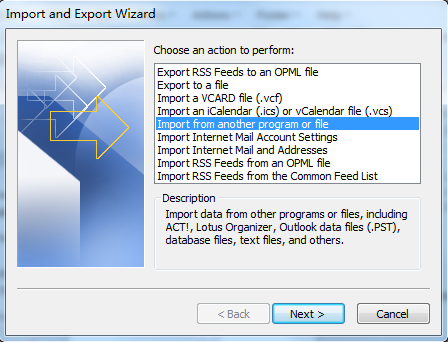

#IMPORT AND EXPORT IN OUTLOOK 2010 HOW TO#
By the end of this article you will know how to backup, export and import Outlook Tasks all by yourself. Leave one or both of these check-boxes unchecked if you only wish to encrypt/sign messages on an individual basis.Īs a rule of thumb, many users choose to digitally sign by default but only encrypt when sending a message which requires confidentiality.Summary: Be it taking a backup of Outlook tasks or exporting Outlook Tasks to Excel or another computer.

To sign every message by default, check the 'Add digital signature.' box To encrypt every message by default, check the 'Encrypt contents.' box When the mail is sent, it will be signed and/or encrypted per the options selected. To sign or encrypt an individual mail, first compose a new mail or reply to/forward an existing mail.Ĭlick 'Options' on the message menu bar then click one or both of the 'Sign' and 'Encrypt' buttons depending on your requirements. On returning to the 'Change Security Settings' window, you should see your certificate listed as the signing and/or encryption certificate fields.Ĭlick 'OK' to return to the Trust Center screen. Repeat the process for the 'Encryption Certificate', again choosing your Comodo certificate. If you are unsure, you can highlight a certificate and click the 'View Certificate' button to see certificate details. In most cases you should be using your Comodo Personal Authentication Certificate for both signing and encrypting.Ĭlick the 'Choose' button next to the 'Signing Certificate' field.Ī new window will appear which will allow you to choose your signing certificate from the list of imported certificates.Ĭhoose your Comodo Personal Authentication certificate and click 'OK'. The 'Change Security Settings' dialog allows you to choose signing and encryption certificates. In the Trust Center screen, select 'E-mail Security' then click the 'Settings' button. In the Outlook Options screen, click 'Trustcenter' > 'Trustcenter Settings'. Signing and encrypting all mails by default Upon receipt of the signed mail, their certificate will be automatically imported into your certificate store and you will be able to sign/encrypt mail to that person. To obtain their certificate, you need to get your contact to send you a signed email. Note: In order to encrypt mail, you must first have your recipient’s email certificate in your certificate store. Signing an email ensures the recipient knows the email has come from you and informs them that it has not been modified in transit.Įncrypting an email ensures that only the recipient can read the email content and attachments. You have successfully imported your Comodo Personal Authentication certificate into Outlook 2010 / 2013. Select the security level for storing the Private Key in your system and click OK.
#IMPORT AND EXPORT IN OUTLOOK 2010 PASSWORD#
Enter the password that was used while exporting the certificate and provide a Digital ID name. In the Import/Export Digital ID interface, navigate to the location of your PKCS12 certificate file and click 'Open'. In the Trust Center screen, select 'E-mail Security' then click the 'Import/Export' button. In the Outlook Options screen, click 'Trustcenter' > 'Trustcenter Settings' Open Outlook 2010 / 2013, then click 'File' > 'Options'. Importing your Certificate into Outlook 2010 / 2013: Importing your certificate into Outlook 2010 / 2013 You can then follow the ' import' instructions in this document. You then need to transfer it to this computer (email it to yourself or save the certificate file to USB then copy over). If your certificate is not already installed on the computer you are using, then please export it from the machine on which it resides using one of the browsers listed on the CPAC main page. You can skip straight to ' Signing and Encrypting'. If you originally applied for the certificate on the same computer as your Outlook installation then it should already be installed.


 0 kommentar(er)
0 kommentar(er)
